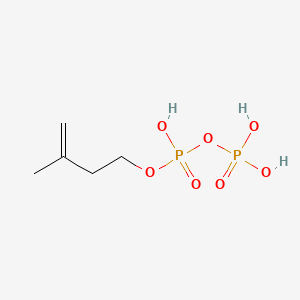| MeSH term | MeSH ID | Detail |
|---|---|---|
| Melanoma | D008545 | 69 associated lipids |
Isopentenyl pyrophosphate
Isopentenyl pyrophosphate is a lipid of Prenol Lipids (PR) class. Isopentenyl pyrophosphate is associated with abnormalities such as Tuberculosis, NAVAJO NEUROHEPATOPATHY and Cryptosporidiosis. The involved functions are known as Signal, Anabolism, T-Cell Activation, T-Cell Proliferation and isoprenoid biosynthetic process. Isopentenyl pyrophosphate often locates in Protoplasm, Host Cell, soluble, Plastids and Cell surface. The associated genes with Isopentenyl pyrophosphate are oxytocin, 1-desamino-(O-Et-Tyr)(2)-, HLA-E gene, RAP1A gene, Gene Family and Orthologous Gene. The related lipids are Steroids, Sterols and isopentenol.
Cross Reference
Introduction
To understand associated biological information of Isopentenyl pyrophosphate, we collected biological information of abnormalities, associated pathways, cellular/molecular locations, biological functions, related genes/proteins, lipids and common seen animal/experimental models with organized paragraphs from literatures.
What diseases are associated with Isopentenyl pyrophosphate?
Isopentenyl pyrophosphate is suspected in Tuberculosis, NAVAJO NEUROHEPATOPATHY, Cryptosporidiosis and other diseases in descending order of the highest number of associated sentences.
Related references are mostly published in these journals:
| Disease | Cross reference | Weighted score | Related literature |
|---|
Possible diseases from mapped MeSH terms on references
We collected disease MeSH terms mapped to the references associated with Isopentenyl pyrophosphate
PubChem Associated disorders and diseases
What pathways are associated with Isopentenyl pyrophosphate
Lipid pathways are not clear in current pathway databases. We organized associated pathways with Isopentenyl pyrophosphate through full-text articles, including metabolic pathways or pathways of biological mechanisms.
Related references are published most in these journals:
| Pathway name | Related literatures |
|---|
PubChem Biomolecular Interactions and Pathways
Link to PubChem Biomolecular Interactions and PathwaysWhat cellular locations are associated with Isopentenyl pyrophosphate?
Visualization in cellular structure
Associated locations are in red color. Not associated locations are in black.
Related references are published most in these journals:
| Location | Cross reference | Weighted score | Related literatures |
|---|
What functions are associated with Isopentenyl pyrophosphate?
Related references are published most in these journals:
| Function | Cross reference | Weighted score | Related literatures |
|---|
What lipids are associated with Isopentenyl pyrophosphate?
Related references are published most in these journals:
| Lipid concept | Cross reference | Weighted score | Related literatures |
|---|
What genes are associated with Isopentenyl pyrophosphate?
Related references are published most in these journals:
| Gene | Cross reference | Weighted score | Related literatures |
|---|
What common seen animal models are associated with Isopentenyl pyrophosphate?
There are no associated biomedical information in the current reference collection.
NCBI Entrez Crosslinks
All references with Isopentenyl pyrophosphate
Download all related citations| Authors | Title | Published | Journal | PubMed Link |
|---|---|---|---|---|
| Fraser PD et al. | Phytoene synthase from tomato (Lycopersicon esculentum) chloroplasts--partial purification and biochemical properties. | 2000 | Planta | pmid:10987554 |
| Scott KM et al. | The genome of deep-sea vent chemolithoautotroph Thiomicrospira crunogena XCL-2. | 2006 | PLoS Biol. | pmid:17105352 |
| Sabehi G et al. | New insights into metabolic properties of marine bacteria encoding proteorhodopsins. | 2005 | PLoS Biol. | pmid:16008504 |
| Nair SC and Striepen B | What do human parasites do with a chloroplast anyway? | 2011 | PLoS Biol. | pmid:21912515 |
| Yeh E and DeRisi JL | Chemical rescue of malaria parasites lacking an apicoplast defines organelle function in blood-stage Plasmodium falciparum. | 2011 | PLoS Biol. | pmid:21912516 |
| Jung KH et al. | Identification and functional analysis of light-responsive unique genes and gene family members in rice. | 2008 | PLoS Genet. | pmid:18725934 |
| Vinella D et al. | Iron-sulfur (Fe/S) protein biogenesis: phylogenomic and genetic studies of A-type carriers. | 2009 | PLoS Genet. | pmid:19478995 |
| Zheng Q et al. | Diverse arrangement of photosynthetic gene clusters in aerobic anoxygenic phototrophic bacteria. | 2011 | PLoS ONE | pmid:21949847 |
| Van Laar TA et al. | Effect of levels of acetate on the mevalonate pathway of Borrelia burgdorferi. | 2012 | PLoS ONE | pmid:22675445 |
| Holderness J et al. | Polysaccharides isolated from Açaà fruit induce innate immune responses. | 2011 | PLoS ONE | pmid:21386979 |
| Atsbaha Zebelo S et al. | Chrysolina herbacea modulates terpenoid biosynthesis of Mentha aquatica L. | 2011 | PLoS ONE | pmid:21408066 |
| Bergman P et al. | Studies on the antibacterial effects of statins--in vitro and in vivo. | 2011 | PLoS ONE | pmid:21912631 |
| Wang L et al. | Genome characterization of the oleaginous fungus Mortierella alpina. | 2011 | PLoS ONE | pmid:22174787 |
| Nymark M et al. | An integrated analysis of molecular acclimation to high light in the marine diatom Phaeodactylum tricornutum. | 2009 | PLoS ONE | pmid:19888450 |
| Kenny JG et al. | The Staphylococcus aureus response to unsaturated long chain free fatty acids: survival mechanisms and virulence implications. | 2009 | PLoS ONE | pmid:19183815 |
| Jawaid S et al. | Kinetic characterization and phosphoregulation of the Francisella tularensis 1-deoxy-D-xylulose 5-phosphate reductoisomerase (MEP synthase). | 2009 | PLoS ONE | pmid:20011597 |
| Tsuruta H et al. | High-level production of amorpha-4,11-diene, a precursor of the antimalarial agent artemisinin, in Escherichia coli. | 2009 | PLoS ONE | pmid:19221601 |
| Correia DV et al. | Highly active microbial phosphoantigen induces rapid yet sustained MEK/Erk- and PI-3K/Akt-mediated signal transduction in anti-tumor human gammadelta T-cells. | 2009 | PLoS ONE | pmid:19479075 |
| Tidten-Luksch N et al. | IspE inhibitors identified by a combination of in silico and in vitro high-throughput screening. | 2012 | PLoS ONE | pmid:22563402 |
| Ma YG et al. | Activation of BK(Ca) channels in zoledronic acid-induced apoptosis of MDA-MB-231 breast cancer cells. | 2012 | PLoS ONE | pmid:22655048 |
